Architecture
Dwelling with a difference
There are certain things that influence in the construction of a house. When they are joined in right proportion, the result will be fabulous. FWD Life traces new trends in architecture.
Sufferings of people who live in concrete buildings are due to the high interior thermal discomfort. The domestic “active” cooling systems consume the most highly wanted precious energy and raise the cost of living. Our ancestors, who lived in tune with the nature, left the old conventional architectural wisdom untold. We built modern concrete jungles, being blind enough to see these magical designs, are now going back to these. The old architects, who used unknowingly most of the building technologies, were passively helping to control the indoor environment to provide thermal comfort.
These systems embedded in the “Kovilakoms” and other old traditional buildings being the signature of the old indigenous Kerala architectural design, is recreated in ‘Cool Home’ through modern technologies. An ultra-Low cost technology with luxurious interior is adopted here to make this the most loudly told success stories in the low cost building construction attempts.
Dr. Dili A. S, Professor, Department of Architecture, TKM College of Engineering, Kollam has recently constructed an Ultra-Low cost Dwelling unit (two bath attached bedrooms with all facilities) on the terrace of an existing old house with a new technology and structural system. This house is equipped with an effective passive environment control system which makes the interior of the house ‘cool’ in all seasons. “This technology has been derived from my scientific research on the passive environment control system of traditional architecture of Kerala. This technology is also applicable for constructing houses in other warm-humid regions of India,” says Dr. Dili.
Natural resources like clay, river sand, rock etc. are heavily exploited for building construction nowadays. This will lead to serious environmental disorder in future. This type of construction reduces the use of such natural resources considerably and save the environment for our posterity. The energy consumption in this house is also very less compared to normal houses.
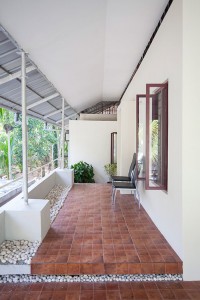
view of the Entry Foyer: The courtyard with plants provided at a lower level from this foyer is also visible.
Project location
The terrace of around 70-year-old single storeyed flat concrete-roofed house (“Kayavil House”) located at Mayyanad in Kollam was selected for the construction of “Cool Home”.
Project requirements
An independent two bedroom dwelling unit for a small family with the following requirements: External stair case, semi open verandah suitable for entry foyer and living, living room, dining room, two bedrooms with attached toilets for each, dining room, kitchen with storage facility, work area, utility space.
Technology
This house is equipped with an effective passive environment control system which makes the interior of the house cool in all seasons. This system is equipped in the building with an attic space above the false ceiling (protected with glass wool insulation) which is well ventilated with slits of appropriate sizes protected by steel grills.
Construction
Construction started from the roof structure. Almost 0.35mm thick, trafford shaped, powder coated steel sheet roof is supported by two inch diameter G.I pipe pillars. G.I rectangular tubes (1 x 3 inches) were used for main truss work of the roof. 1.5 inch steel purloins were used to join the steel sheets with the main truss work. Double protection has been ensured by sealing the holes (from the bottom), generated when the “J” bolts are fitted for joining the purloins with the sheets in additions to the tar washer provided on the top.
Constructing the roof first provides multiple benefits. Labourers are protected from severe weather exterior leads to the enhanced work efficiency. Since the sunlight is not falling on the walls directly, it is possible to ensure proper curing of the masonry at the time of construction of the walls. Four inch thick, locally available concrete hollow blocks are used for the construction of walls with M-sand cement mortar. Stiffness of the wall is related to its thickness. Certain folding has been provided specially to give stiffness to the walls which are thin. Additionally, six inch thick concrete belt has been inscribed into the wall to add a tie effect to the walls. This belt, reinforced by eight inch diameter steel bars, act as lintel beam above the doors and windows.
Total height of the walls is fixed at nine feet and it helped to reduce the cost of construction. River sand has been used for plastering and it improved the finishing of the walls when emulsion paint was applied with rollers on smooth putty work.
Another specialty of this design is the use of low cost windows. Steel windows are made of two inch G. I. square tube outer frames and the same tube of one inch size shutter frames. The four millimeter thick glass panes are directly fixed on the shutter frames using silicone sealant.
Instead of concrete slabs, high finished gypsum board false ceiling has been provided above the walls. The heat flow through the roof and false ceiling towards the interior is controlled by two inch thick glass wool which is evenly laid on the top of gypsum board. An attic space between the roof and false ceiling has been set up as a passive thermal control system to provide comfort to the interior space. Security is ensured by a grill work of 10mm diameter steel bars around the attic space above the external walls. This is working as a passive thermal control system similar to the attic space in traditional houses of Kerala. Heat transmitted to the attic space from the roof is directed to the outside air through the grills. Fiber net covering the external grills around the attic space protects the area from external surroundings.
Pre-laminated wood is used for flooring the bedroom and living area. Premium quality vitrified tiles are used for flooring the other rooms. Factory made doors with processed wood are used for external and bedroom doors. PVC doors are used for toilets. To make the “poomukham” more attractive, terra cotta coloured rustic finish tiles, pebble courtyard, pebble boarders, indoor plants, low sitting area, and calcium silicate false ceiling are used and it has proved that the design has not compromised on the beauty and finish of the house for reducing the cost.
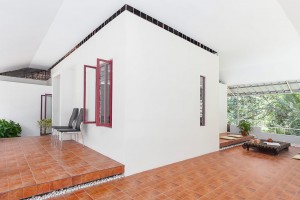
View of Poomukham : Calcium Silicate false ceiling is provided on the top, The Slits with Grills provided for the hot air to escape form the attic space is also visible
Design result
Semi open space, living room, dining room, kitchen, work area, utility space and two bath attached bedrooms were included in the new “Cool Home” and it was perfectly finished with a plinth area of about 1350 square feet. The total cost of construction amounts to Rs. 6.8 lakh only. The terrace taken for the construction has been made with different levels in the past by some additions and modifications. It has changed this into a multi level terrace. This multi-level terrace building top has been made attractive and useful by this new design.
Front lower terrace has been attached to the semi open verandah. This appears like the conventional sit out (Poomukham) and entry to this portion is from the stair case provided outside in its lower most portion. This stair case has been made with steel framework having one inch thick Ferro cement slabs as treads. The main entrance to the house is from the “Poomukham” through an entry foyer at a rise of eight inches. The pebble courtyard with plants provided at a lower level (17 inches) from this foyer has made the main entrance attractive.
Entry foyer, living room and one bath attached bedroom are at the same level. Entry to the dining room situated seventeen inches below the living room, has been given access with granite steps fixed in steel fabricated framework. Dining, another bath attached bedroom, Kitchen and work area are at the same level. Utility space has been provided at a three steps depth from the work area. Low cost building with high finishing and cool interior has been a dream and it has come true.
*Courtesy:
Dr Dili. A.S, Architect
Mob: 94473 03875
Architecture
Creating a Cozy Living Room: Tips for Comfort and Style

Your living room is more than just a space for entertaining; it’s a sanctuary where you unwind, relax, and spend quality time with loved ones. Creating a cozy living room involves a blend of comfort and style that makes the space inviting and functional. Here are some tips to help you achieve that perfect balance:
Choose the Right Furniture
Start with furniture that combines comfort and functionality. Opt for a plush sofa with deep cushions, perfect for lounging. Consider adding a cozy armchair or a recliner for additional seating. Make sure the furniture arrangement promotes conversation and allows for easy movement throughout the room.
Layer Your Lighting

Lighting plays a crucial role in setting the mood. Use a mix of lighting sources to create a warm ambiance. Combine overhead lights with floor lamps, table lamps, and wall sconces. For added coziness, incorporate dimmers or smart bulbs that let you adjust the brightness to suit different times of day and activities.
Add Textures with Throws and Pillows
Textures are key to a cozy living room. Layer different fabrics, such as soft throw blankets, plush pillows, and textured rugs. Choose fabrics like wool, velvet, and cotton that add warmth and comfort. Mix and match patterns and colors to create visual interest and a personalized touch.
Incorporate Warm Colors
Color influences the feel of a room. Opt for warm, neutral tones like beige, taupe, or soft gray for a calming effect. Accents in rich colors like deep blues, earthy greens, or warm terracotta can add depth and coziness. Use these colors in your furniture, accessories, and wall decor.
Use Rugs to Define Spaces
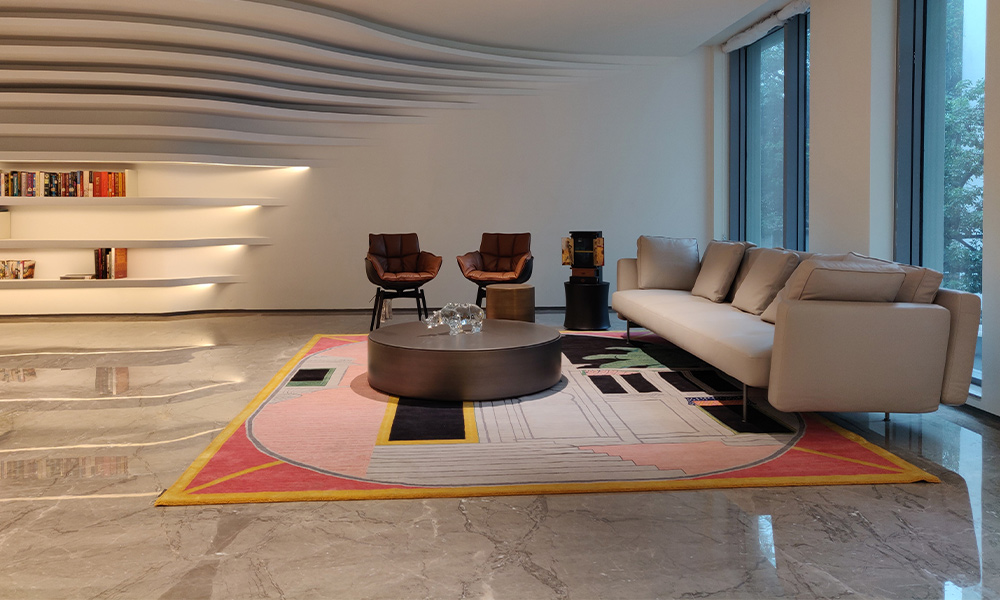
Rugs can help define different areas within a living room and add a layer of warmth underfoot. Choose a rug that complements your furniture and adds softness to the space. A large area rug can anchor the room, while smaller rugs can be used to highlight specific areas, like a reading nook or conversation zone.
Incorporate Natural Elements
Bring the outdoors in by incorporating natural elements. Plants not only add a touch of greenery but also improve air quality and create a calming atmosphere. Choose low-maintenance plants like succulents or snake plants if you’re not an avid gardener. Wooden furniture or decor pieces can also add a natural, grounded feel to the room.
Personalize with Artwork and Décor
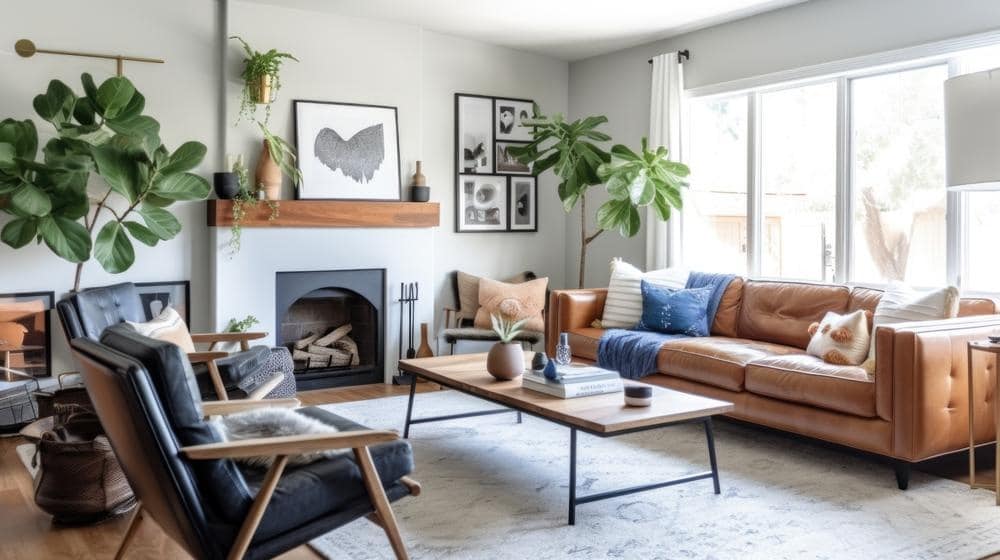
Add personality to your living room with artwork and decorative items that reflect your style. Choose pieces that resonate with you, whether it’s family photos, abstract art, or vintage finds. Arrange decor items in groups to create visual interest and avoid clutter.
Create a Focal Point
A focal point helps draw the eye and creates a sense of balance in the room. This could be a fireplace, a statement piece of art, or a stylish coffee table. Arrange your furniture and decor around this focal point to enhance the room’s overall cohesion and appeal.
Invest in Quality Window Treatments
Window treatments can impact both the look and feel of your living room. Opt for curtains or blinds that provide privacy while allowing natural light to filter through. Choose fabrics that complement your decor and add texture, such as linen or velvet.
Add Personal Touches
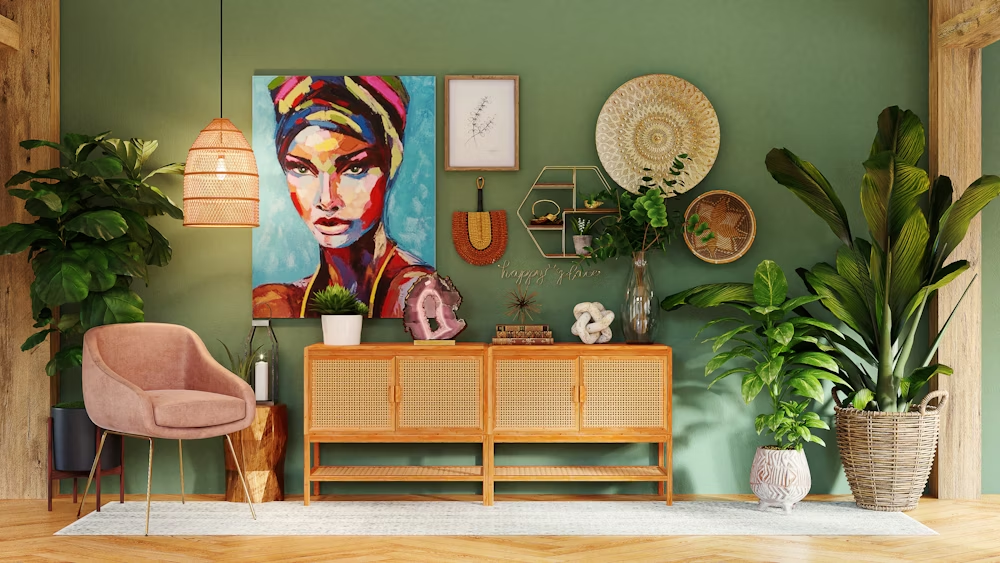
Finally, make the space truly yours by adding personal touches. Incorporate items that have sentimental value or reflect your interests and hobbies. Whether it’s a collection of travel souvenirs, a beloved quilt, or unique decorative objects, these elements will make your living room feel more inviting and personal.
By thoughtfully combining these elements, you can create a cozy living room that serves as a comfortable retreat and a stylish gathering place for friends and family. Enjoy the process of making your space uniquely yours and revel in the comfort and warmth it provides.
Architecture
The Art of Feng Shui: Creating Harmony in Your Home

Feng Shui, an ancient Chinese art and science, is all about creating harmony and balance in our living spaces. By arranging our homes in accordance with Feng Shui principles, we can invite positive energy, known as “chi,” into our lives and promote health, wealth, and happiness. In this blog post, we’ll explore the fundamentals of Feng Shui and share practical tips for applying its principles to create a harmonious and inviting home environment.
Understanding the Basics of Feng Shui:
Feng Shui is based on the concept of “chi,” or life force energy, which flows through our environments and influences our well-being. The goal of Feng Shui is to create a harmonious flow of chi by arranging our surroundings in a way that promotes balance and harmony. This includes paying attention to the layout, orientation, and organization of our homes to optimize the flow of energy.
The Five Elements of Feng Shui:
In Feng Shui, there are five elements—wood, fire, earth, metal, and water—that represent different qualities and energies. By incorporating these elements into our home decor, we can create a sense of balance and harmony. For example, wood represents growth and vitality, while water symbolizes flow and abundance. By incorporating a balance of these elements into our living spaces, we can enhance the flow of positive energy and create a sense of equilibrium.
Applying Feng Shui Principles to Your Home:
Clearing Clutter: Clutter can block the flow of chi and create stagnant energy in our homes. Start by decluttering your space and getting rid of items that no longer serve a purpose. This will create space for fresh energy to flow and rejuvenate your home.
Balancing Yin and Yang: In Feng Shui, yin and yang represent the balance of feminine and masculine energies. Create a harmonious balance of yin and yang in your home by incorporating soft, nurturing elements (yin) with strong, active elements (yang).
Enhancing the Flow of Chi: Pay attention to the layout and arrangement of furniture in your home to optimize the flow of chi. Avoid placing furniture in direct line with doorways or blocking pathways, as this can disrupt the flow of energy. Instead, create open and inviting spaces that allow chi to circulate freely.
Incorporating Nature: Bring the outdoors in by incorporating elements of nature into your home decor. Plants, natural materials, and natural light can enhance the flow of chi and create a sense of vitality and well-being in your living spaces.
Room-By-Room Feng Shui Tips:
Living Room: Arrange furniture in a circular or semi-circular layout to encourage conversation and social interaction. Use soft, natural fabrics and incorporate elements of wood and fire to create warmth and intimacy.
Bedroom: Position your bed diagonally across from the door to command a clear view of the room while you sleep. Keep the space under your bed clear and clutter-free to promote restful sleep and relaxation.
Kitchen: Keep your kitchen clean, organized, and clutter-free to promote health and abundance. Incorporate elements of fire and earth, such as candles and earthy tones, to create a warm and inviting atmosphere for cooking and dining.
By incorporating the principles of Feng Shui into your home decor, you can create a harmonious and balanced living environment that supports your health, happiness, and overall well-being. Whether you’re decluttering your space, balancing yin and yang energies, or enhancing the flow of chi, the art of Feng Shui offers timeless wisdom and practical guidance for creating a sanctuary of peace and tranquility in your home.
Architecture
5 Sustainable Interior Design Trends to Embrace in 2024
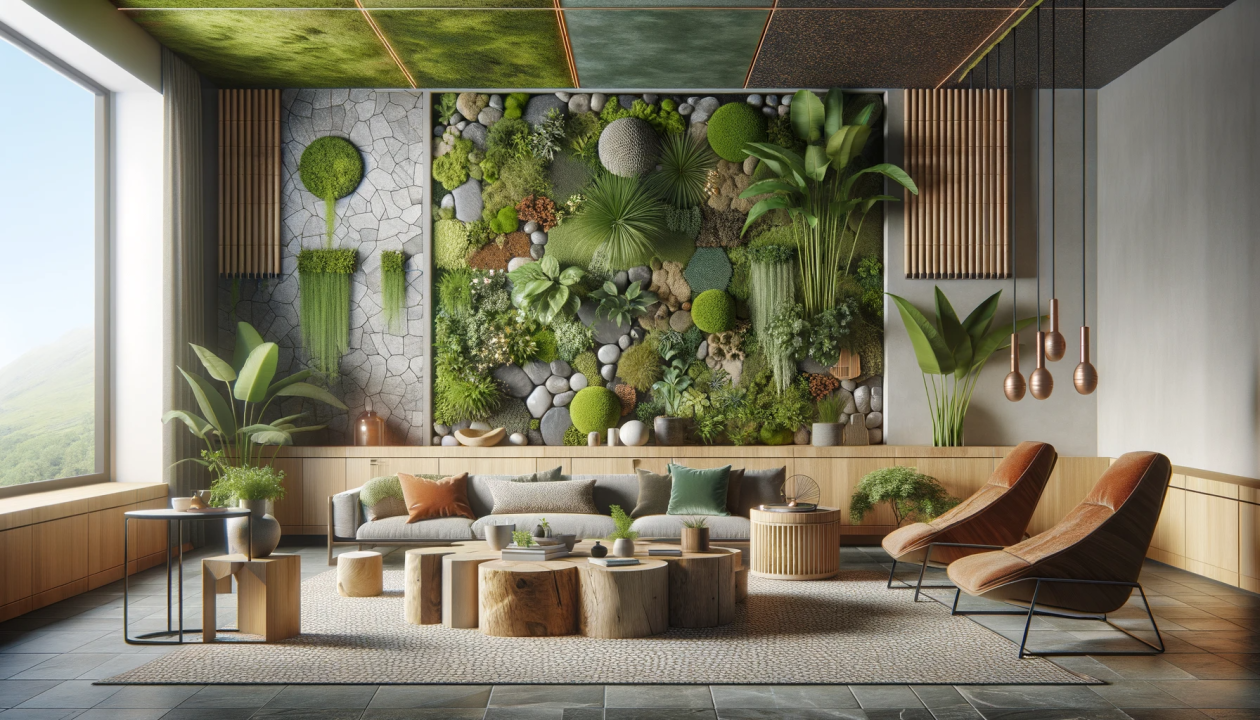
As the world becomes increasingly aware of the importance of sustainability, it’s no surprise that eco-friendly practices are making their way into the realm of interior design. In 2024, we can expect to see a surge in sustainable interior design trends that not only enhance the beauty of our living spaces but also minimise our environmental footprint. From repurposed materials to energy-efficient solutions, here are five sustainable interior design trends to embrace this year.
Upcycled Furniture:

One of the most prominent sustainable interior design trends of 2024 is the use of upcycled furniture. Instead of buying new pieces, consider giving old furniture a new lease on life by refurbishing or repurposing them. From reclaimed wood tables to refurbished chairs, upcycled furniture adds character and charm to your space while reducing waste and conserving resources.
Biophilic Design:

Biophilic design, which emphasizes a connection to nature, continues to gain popularity in 2024. Integrating natural elements such as plants, natural light, and organic materials into your interior design not only enhances aesthetics but also promotes well-being and sustainability. Consider incorporating living walls, indoor gardens, and sustainable wood finishes to bring the outdoors inside and create a healthier living environment.
Energy-Efficient Lighting:

With a growing focus on energy conservation, energy-efficient lighting solutions are becoming a staple in sustainable interior design. LED lights, in particular, consume significantly less energy than traditional incandescent bulbs and last much longer, reducing both energy consumption and maintenance costs. Additionally, consider incorporating natural light sources such as skylights and large windows to maximize daylight and minimize the need for artificial lighting during the day.
Sustainable Textiles:

When it comes to upholstery and soft furnishings, opting for sustainable textiles is key to reducing environmental impact. Look for fabrics made from organic or recycled materials, such as organic cotton, hemp, bamboo, or recycled polyester. These materials not only reduce the use of harmful chemicals and pesticides but also minimize waste and support eco-friendly production practices. Additionally, consider investing in durable, high-quality textiles that stand the test of time, reducing the need for frequent replacements.
Smart Home Technology:

In 2024, smart home technology continues to evolve, offering innovative solutions for sustainable living. From smart thermostats that optimize energy usage to home automation systems that control lighting and appliances, these technologies can help reduce energy consumption and increase efficiency in your home. Additionally, smart home devices such as occupancy sensors and smart meters provide valuable insights into your energy usage, empowering you to make informed decisions about resource management and conservation.
As we strive to create more sustainable living environments, embracing these five interior design trends can help reduce our environmental impact while creating beautiful and functional spaces. Whether you’re upcycling old furniture, incorporating natural elements, or investing in energy-efficient technologies, every sustainable choice contributes to a greener future for generations to come. So let’s embrace these trends and make sustainability a cornerstone of our interior design practices in 2024 and beyond.
-

 Style11 months ago
Style11 months agoBridal Guide : Best Looks of Radhika Merchant Ambani
-

 Entertainment1 year ago
Entertainment1 year agoThe Stunning looks from Bhagya Suresh’s Wedding
-

 Fashion1 year ago
Fashion1 year agoMost Discussed Ajrakh Saree of Alia Bhatt
-

 Entertainment1 year ago
Entertainment1 year agoThe Most Stylish Guests of Bhagya Suresh Reception
-

 Entertainment1 year ago
Entertainment1 year agoBridal Bliss : All Bridal Looks of Swasika Vijay
-

 Movies1 year ago
Movies1 year agoA Nostalgic Journey Through Love &Cinema : Best Bollywood Romantic 90s Movies
-

 Fashion1 year ago
Fashion1 year agoMajor Denim Trends You Need To Know in 2024
-

 AD8 months ago
AD8 months agoPopular Curtain Fabrics to Consider for Your Home





























